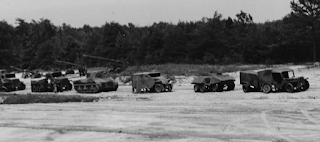Imagine being a German field commander and
hearing a tank battalion crank up a mile away, or an infantry regiment on the
move just beyond that rise up ahead. What would you do? Chances are, what you
heard was merely a sound recording.
 |
| Ghost Army logo |
The U.S. Ghost Army was a
1,100-man unit officially known as the 23rd
Headquarters Special Troops. The tactical deception unit impersonated
other U.S. Army units to deceive the enemy during World War II. They used fake
tanks, aircraft, and artillery, equipment pioneered by British, and used giant
speakers to broadcast the sounds of men and artillery. Their ruses made the
Germans think they were facing large forces, and deflected German units from
the locations of actual allied combat units.
The American unit sailed for the
England in early May 1944, and participated in Operation Fortitude, the
British-designed and led D-Day deception of a landing force designated for the
Pas-de-Calais. They then went to France and, until the end of the war, put on a
“traveling road show” utilizing inflatable tanks, sound trucks, fake radio
transmissions, and pretense. They staged more than 20 battlefield deceptions,
often operating very close to the front lines.
 |
| 93 pound inflatiale tank |
Many of the ghosts had been
actors, set designers, artists, and engineers, recruited from occupations that
required creative thinking. Others were meteorologists and sound technicians.
Among them were fashion designer Bill Blass and movie star Douglas Fairbanks
Jr.
For visual deception, their
equipment included inflatable airplanes, cannons, jeeps, tanks, and trucks that
they inflated with air compressors. Imperfect camouflage allowed enemy air
reconnaissance to see them. In a few hours, they put together dummy airfields,
artillery batteries, motor pools, tank formations, and troop bivouacs, complete
with fake laundry hanging out to dry.
Sounds of armored and infantry
units were recorded, and mixed for each deception to match the desired scenario
they wanted the enemy to believe. Played on powerful amplifiers and speakers
mounted on halftracks, they could be heard fifteen miles away.
The Signal Company
handled spoof radio, creating phony
traffic nets and impersonating the radio operators from real units. Special
operators were educated in mimicking a departing operator’s idiosyncratic method
of sending Morse Code so that the enemy would never detect that the real unit
and its radio operator were long gone.
Divisional
insignia of units deployed elsewhere were applied on vehicles. To create the
illusion of long convoys, trucks were driven in looping routes with two
soldiers seated in the rear to suggest an entire infantry unit being
transported under the canvas covers.
 |
|
Since the dummy
equipment was positioned in the dark, an inflated tank would sometime be
discovered in the morning facing the wrong way, a dead giveaway to aerial
reconnaissance. The morning sun could cause trouble, too. One day some rubber
planes began collapsing with a series of loud reports because the sun heated
air had expanded. There was trouble with leaks, too. The troops dreaded the
sight of limp gun barrels at first light, when the German reconnaissance planes
usually flew over.
|
The actors in the
Ghost Army spent time at French cafes near the war’s front, spreading gossip
among enemy spies who might be there. Some dressed up as Allied generals and
visited towns where the spies would be likely to see them.
How successful
were the effects of the 23rd's operations? Sometimes they seemed to have no
impact whatsoever. Other times they confused other Allies more than the enemy.
Often enough, though, the Germans were completely bamboozled. Axis Sally, the
radio propagandist, reported an entire Allied division was preparing for battle
in a spot that actually contained, at the time, no troops at all. Prisoners
spoke in awed terms of an "elusive" division. A map overlay captured
before one engagement showed that the enemy had mistakenly positioned a U.S.
unit right where the 23rd wanted them to think it was.
An adverse effect
of their successful illusions resulted when the Germans believe they were real
combat units and called down fire on them. Operating so close to the front
lines left them as battle scarred as the troops they impersonated.
The Ghost Army’s
role was to create the illusion that their military force was bigger and more
powerful than it actually was. They were to create chaos and confusion.
They are estimated to have saved many thousands of soldiers’ lives with its
deceptions, and to have been instrumental in several Allied victories in
Europe. Yet the story of the Ghost Army remained a military secret until its
declassification in 1996, and aspects of it remain classified.
In the words of
one veteran who served alongside them in their most impressive performance at
the Battle of the Rhine, “These men are real heroes―not heroes because they
killed a lot of Germans―heroes because they saved thousands of American lives.”










